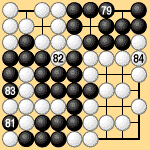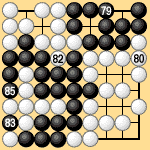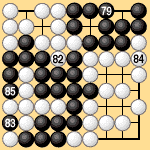
4.2 The Last-Competitive-Move Rule (2)
|
In Dia. 4-2-4, what is the last move that gains anything? Ordinarily Black 'c' would be considered the last move, but suppose that White passes instead of playing 80, as in Dia. 4-2-5: the end result is the same. |
 |
 |
| Dia. 4-2-4 | Dia. 4-2-5 pass: 80 |
|---|
|
What this means is that after Black 79, White already has nothing to gain by making the next move. He can pass and let Black play next, and still get the same result. Not only that: if White plays 80, then Black can pass with 81 and get the same result, as you may verify in Dia. 4-2-6. |
 |
 |
| Dia. 4-2-6 pass: 81, 84 |
Dia. 4-2-7 pass: 80, 81 |
|---|
|
You should also verify that if Black passes at 79, White plays 'b' in Dia. 4-2-4 and Black loses an entire group, either in the bottom left or top right. Black cannot afford to pass at 79. Sente is still worth something at this point. We see in this way that under area rules, in general there comes a time at which the player whose turn it is can pass and let his opponent play instead without having this affect the subsequent result. This point at which sente ceases to bring any gain is what we want to define as the point where the last competitive move has been made. Black 79 in Dia. 4-2-4 is therefore the last competitive move of the game. As a way of indicating that he thinks the result of the moves after Black 79 will be unchanged even if he passes, it would be natural and logical for White actually to pass at this point. If White's judgment is wrong, his pass will cost him something. We can accomplish our purpose by formulating the definition of the last competitive move in the rules in the following way. A player's score is the number of stones that player has on the board plus the number of empty points in that player's territory. If the first pass was made by White, however, then half a point is subtracted from Black's score and added to White's score. This is rule 7 (the rule of scoring) in area rules III. This rule requires the following modification in the rule about the end of the game: after the first pass, the game ends when both players pass in succession. This is rule 6 (end of the game) in area rules III. The meaning of these rules is clear. When Black or White decides that sente is no longer worth anything and passes, the immediately preceding move becomes the last competitive move. If Black passes first he gains one point, because half a point is not taken from him and given to White. If White passes first, then White gains one point. In Dia. 4-2-5 Black wins by five points under area rules II. If White passes at 80 after Black 79, then under area rules III half a point is taken away from Black and given to White, making the margin of victory four points. If White plays 80 by mistake, Black will immediately pass with 81, making White 80 the last competitive move, and Black will win by five points. This is White's fault for not passing at 80. Let's return to Dia. 4-1. If Black can read out that a move at 'a' is not necessary, then he can pass with Black 5. White 4 becomes the last competitive move. If Black thinks that a move at 'a' is necessary he can play Black 5 at 'a,' then White can pass with 6, making Black 5 the last competitive move. Defining the last competitive move as the move immediately preceding the first pass in this way gives both players fair means and fair opportunity to determine when the last competitive move has been made. They will not have to study the game after it has ended to decide who made the last competitive move. |
 |
| Dia. 4-1 |
|---|
|
Attempts to define the last competitive move in terms of the position on the board will run into the same sort of difficulties as attempts to define life and death. Initially I tried to define the last competitive move in this way. I failed, but I discovered the existence of the point at which sente loses its value. I realized that this was an important point in the game, with basic implications for the rules. The end of the game under territory rules has, in fact, traditionally been the point at which sente ceases to have any value. This concept is a key point of contact between area rules III and territory rules. An important fact that can be established is that my proposed territory rules I, which count territory and prisoners, give exactly the same result as area rules III. |
